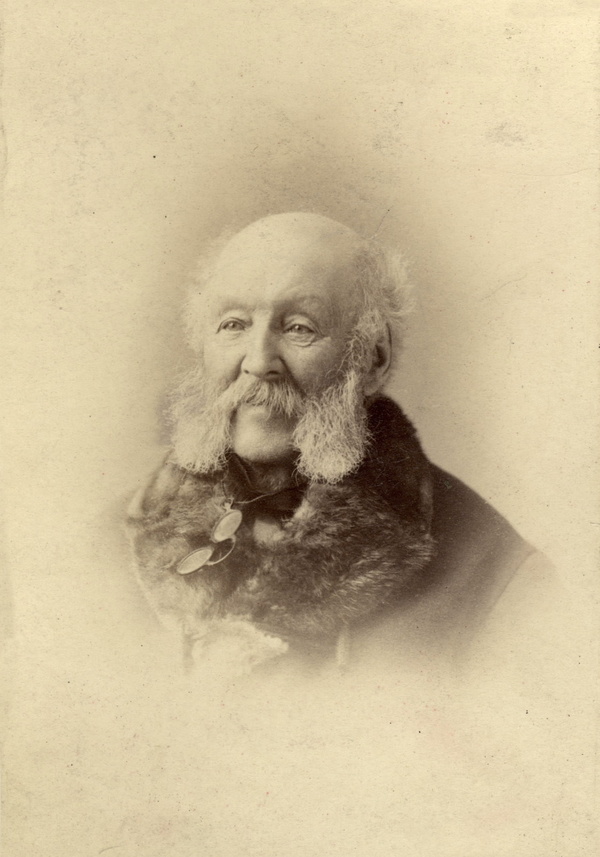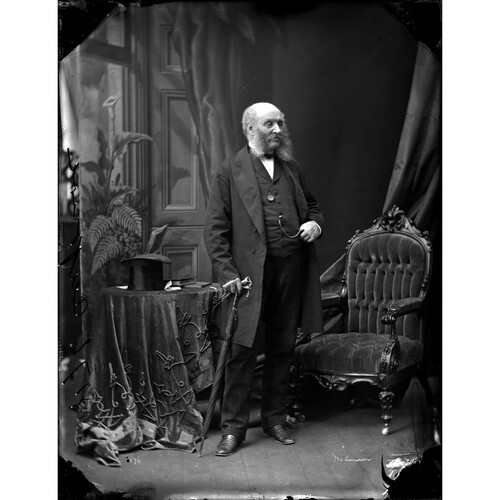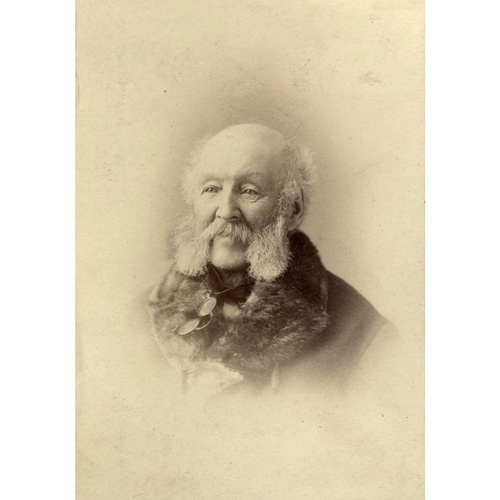CAPREOL, FREDERICK CHASE, businessman and promoter; b. 10 June 1803 at Bishop’s Stortford, Hertfordshire, England, second son of Thomas and Fanny Capreol; m. in 1833 Miss Skyring, and they had 11 children; d. 12 Oct. 1886 in Toronto, Ont.
Frederick Chase Capreol received a “commercial education” in England before arriving in Canada in 1828. For the next two years he resided in Montreal and participated in “settling up the affairs of the North West Fur Company.” Capreol went back to England in 1830 but returned to Canada in 1833. He landed in New York where he married a woman he had met during the crossing and the couple continued to York (Toronto), Upper Canada; there they settled.
Although Capreol pursued various careers, such as real estate agent and pedlar of portraits of Queen Victoria and Sir Francis Bond Head*, his main occupation was the operation of an auction room which he opened in 1833 and continued until about 1850. In November 1833 he purchased a large amount of wild land near the Credit River. But because the original owner, an alcoholic of unsound mind, had been plied with liquor for two days at Capreol’s home during the negotiation of the agreement, the Court of King’s Bench overturned the transaction. Henceforth the financial and social élite of Upper Canada regarded Capreol with suspicion. His impetuosity was displayed in 1843, when the police refused to act immediately after the murder of his friend Thomas Kinnear. Chartering a steamer in the middle of the night, Capreol pursued and captured the murderers, Grace Marks and James McDermott, near Lewiston, N.Y. He was never reimbursed for the expense he incurred.
In July 1848 Capreol began to promote the building of a railway from Toronto to Georgian Bay. Undaunted by the failure of both the Great Western and the City of Toronto and Lake Huron railway companies to attract money, he was supremely confident. When the administration of Robert Baldwin* and Louis-Hippolyte La Fontaine* reserved for royal assent legislation passed by the assembly granting the road a charter, “mad Capreol” rushed to England and acquired the queen’s approval. He returned in August 1849 and took his place as a director at the first meeting of the board of the Toronto, Simcoe and Lake Huron Union Rail-road Company, later renamed the Northern Railway Company of Canada.
Earlier railway construction in Canada had been seriously impeded by lack of capital. In hopes of overcoming this obstacle Capreol sponsored a “Grand Canadian Railroad Lottery” with prizes of land and stock valued at $2,000,000. In January 1850 he petitioned the Toronto City Council to invest £100,000 in tickets by means of debentures but, persuaded by alderman John George Bowes*, it decided to hold a referendum on the debenture issue. Capreol’s plans evoked contrary reactions. Young patricians such as James McGill Strachan* and George William Allan and rising financiers such as John Cameron, Ezekiel Francis Whittemore*, and James Mitchell supported him. Others, including many merchants, manufacturers, and workers, felt that the lottery fed on “a strong temptation to attain wealth without labour” and believed that anyone who could conjure up such a “demoralizing device” must have private gain in mind. Unfortunately for Capreol, the public did not share his confidence. The lottery collapsed after the debenture plan was decisively defeated. However, “the City took Stock in the Railway to an amount of £50,000 . . . [and] the Company was able to go on with the work.”
Late in 1850, while he was arguing with the company’s board of directors over suitable remuneration for expenses incurred in the promotion of the railway, Capreol concluded a contract with a New York firm of railway contractors, Storey and Company, to build the road. The public impact of this event made the board more receptive to Capreol’s requests and in December he received £11,000 in company bonds payable over a seven-year period, bearing interest from 1 Jan. 1852. Yet he was still regarded with suspicion by the financial élite of Toronto. Through their mouthpiece, the board of trade, the merchants supported the railway, but not Capreol. The directors of the railway fired him from his position as manager two days before the sod-turning ceremony on 15 Oct. 1851. He had done well financially but he was denied the prestige, which to Capreol was more important, that would have accompanied the position of manager of Toronto’s first successful railway.
Although his involvement with the Northern Railway was the high point of his public life, Capreol continued to be so busy that he once confided: “I have scarce time for the necessary calls of nature.” In 1853 he became the first president of the newly chartered Metropolitan Gas and Water Company, and in 1863, along with Malcolm Cameron* and John Willoughby Crawford*, he incorporated the General Manufacturing Company of Peel. After the failure of this attempt at the manufacturing of cotton products, he turned to the final and possibly the grandest promotional scheme of his career. From 1865 until the 1880s he was obsessed with the idea of building a canal to link lakes Huron and Ontario. Capreol turned the first sod at the formal commencement of the Huron and Ontario Ship Canal on 17 Sept. 1866. He hoped world-wide recognition would accompany a successful project but his single-handed attempt to promote the multimillion-dollar enterprise failed.
The consistency of Capreol’s failure in politics was only interrupted once. He ran repeatedly after 1843 in St George’s Ward for election to the Toronto City Council. Until 1853 he always lost, generally finishing last. But in a by-election late in that year, occasioned by the resignation of Edward Graves Simcoe Wright, Capreol was finally elected to the council. He sat on council for only two months and attended infrequently. In 1842, running as an independent in Toronto, Capreol had made his first foray into provincial politics. He finished last. After confederation he attempted twice, without success, to gain election to the Ontario legislature. In his first attempt, in 1872, Capreol arrived at the nadir of his undistinguished political career when he failed to receive a single vote.
For Capreol the 1880s were years of bitterness and disappointment. He informed Sir John A. Macdonald* that he had spent 52 years of his life on great projects for which he “had crossed the Atlantic 23 times,” but he had never received a proper reward. Even a card imprinted with a basket of forget-me-nots sent to Macdonald did not result in the knighthood he had requested. Although Capreol died a man of means, his career did not bring him the acclaim and public honours he so deeply coveted. The only memorial to him is a small railway junction town in northern Ontario that bears his name.
CTA, Toronto City Council papers, 1847–52 (mfm. at AO). MTL, Robert Baldwin papers. PAC, MG 24, B30; D 16; MG 26, A; RG 30, 1414; RG 31, A1, 1861, Toronto, St George’s Ward. Doe ex dem. Jones v. Capreol (1834/35), 4 U.C.Q.B. (O.S.) 227. British Colonist (Toronto), 1839–54. Globe, 1845–61; 14 Oct. 1886. Leader, 1853–60. Patriot (Toronto), 1835–39, 1850–54. Toronto Daily Mail, 13 Oct. 1886. Morgan, Sketches of celebrated Canadians. P. A. Baskerville, “The boardroom and beyond; aspects of the Upper Canadian railroad community” (phd thesis, Queen’s Univ., Kingston, Ont., 1973). B. D. Dyster, “Toronto 1840–1860: making it in a British Protestant town” (1v. in 2, phd thesis, Univ. of Toronto, 1970). A. F. Hunter, Ahistory of Simcoe County (2v., Barrie, Ont., 1909; repr. 1948), I. Masters, Rise of Toronto. W. H. Pearson, Recollections and records of Toronto of old . . . (Toronto, 1914). Robertson’s landmarks of Toronto, I. C. C. Taylor, Toronto “called back,” from 1894 to 1847 . . . (Toronto, 1894). Elwood Jones and Douglas McCalla, “Toronto waterworks, 1840–77: continuity and change in nineteenth-century Toronto politics,” CHR, 60 (1979): 300–23. R. D. Smith, “The Northern Railway: its origins and construction, 1834–1855,” OH, 48 (1956): 24–36.
Cite This Article
Peter Baskerville, “CAPREOL, FREDERICK CHASE,” in Dictionary of Canadian Biography, vol. 11, University of Toronto/Université Laval, 2003–, accessed December 27, 2025, https://www.biographi.ca/en/bio/capreol_frederick_chase_11E.html.
The citation above shows the format for footnotes and endnotes according to the Chicago manual of style (16th edition). Information to be used in other citation formats:
| Permalink: | https://www.biographi.ca/en/bio/capreol_frederick_chase_11E.html |
| Author of Article: | Peter Baskerville |
| Title of Article: | CAPREOL, FREDERICK CHASE |
| Publication Name: | Dictionary of Canadian Biography, vol. 11 |
| Publisher: | University of Toronto/Université Laval |
| Year of publication: | 1982 |
| Year of revision: | 1982 |
| Access Date: | December 27, 2025 |





